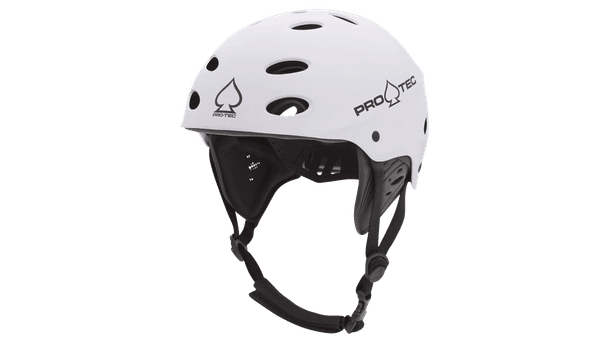- Home
- Gear & Reviews
- Sails
Sails

Sails Description
The Sails is a accessory brought to you by Pacific Action Sails. Read Sails reviews or submit your own review to share with the paddling community. Check out a few other accessory recommendations below or explore all accessories to find the perfect one for you!
Pacific Action Sails
Sails Reviews
Read reviews for the Sails by Pacific Action Sails as submitted by your fellow paddlers. All of the reviews are created and written by paddlers like you, so be sure to submit your own review and be part of the community!
I've had both the 1.5 and…
I've had both the 1.5 and 1.0m² PA sails over the years. The 1.5 was run on my Prijon Marlin - a fast enough boat under paddle-power although deploying it in 25kts on a straight downwind run clocked me at 15kts. Alternating between yells of exhiliration..and girly squeals of terror!
I sold that one when I moved the Prijon on and got a 1.0 for my fishing and touring yaks, less punchy but still skips along nicely and less deck clutter around the cockpit.
Recommend fitting permanent anchors if you're going to use it more than occassionally, really makes a difference. Composites may need a simple layup of carbon mat under the foredeck for strength, if the sail rocks from side to side, the straps aren't cranked up enough.
Would I buy another? Absolutely.
What fun! If you're looking…
I run a number of PA sails…
I bought a pacific action 1.5…
The cleats that come with the sail are horrible. I rigged 2 ($5 each) jam cleats to my boat and now it only takes 1 hand to adjust the line. Now I do not have to let go of my paddle to adjust the sheets. One other downside that is hard to correct is the bulkiness of the sail when it is down. It just gets in the way. As soon as I know sailing is over I head to land to take the rig off. There is no practical way to completely remove the sail away from land.
I cannot wait for my next long day wilderness trip. If it is a down wind leg I am going to beat my group to the next camp site by a lot. Nobody can beat a kayak with a sail in the right conditions. I highly recommend the Pacific Action sail. Consider buying the larger sail and remove some of the mast for a home made sail of a smaller size.
I bought the smaller sail…
I have had Pacific Action…
The Good I am very hard to impress and at a price of…
I am very hard to impress and at a price of about $350 US taxed and shipped for the 1 meter sail I turn into impossible to impress. The sail impressed me. A lot, frankly. All components are of the highest quality. Workmanship is flawless. The design is right on and is a snap to learn to use. Easy to set up and take down, I have trained a 12 yr old and a 15 yr old to use it well with just a two minute class. Most of that two minutes was spent impressing the importance of speed in striking the sail and securing it to the bungie. Everyone I have taken out sailing in my double baidarka has been a non paddler and absolutely had a blast. It is especially cool when the hull starts to make that gurgling sound as water passes under it. I went out on a test sail in very high winds and the kayak rocketed along comfortably. I was advised to modify the rig a bit and did. I replaced the original sail control line or sheet with two ten foot pieces of sheet material. I installed two deck clamcleats. All of this really helped and cost an additional $30. Sail control was simplified, became more precise and physically easier.
The Bad
The only strong criticism of the PA sail concerns the instructions for installation. As a person who has built four kayaks from kits and a Melonseed sailboat from a line drawing and not much else I found the PA sail instructions almost useless. I went on line and looked at photos of installed PA rigs to wing it as best I could. A critical step to pay attention to is mounting the twin sail posts that hold the sail erect. You must ensure that the twin posts, which look like your fingers making a peace sign, are spread out as far as possible so the sail sets flat. This will take two helpers or some jury rigging to hold the posts away from each other. The posts are then permanently set at this angle with a pair of screws bisecting the posts. Get it wrong and you either have to redrill the posts possibly weakening them or live with your error.
I would spend the money again in a heartbeat.
I have been using the Pacific Action 1.1 meter sail on…
The most interesting feature of this design of "V" sail is the sheet attached to the midline of the split via mast on either side. This does allow adjustable sail trim, and in light air does allow for relatively safe and fast reaching. I would never have thought possible the ability to reach in a kayak with limited or no feeling of capsizing. The boat appears to track well at this point-of-sail, and does not necessarily require the skeg down.
Installation does require drilling the holes in your boat, including two small brackets to hold the base of the mast, and in my case I placed to the cam cleats just in front of the cockpit which are very functional, and are useful for other applications than the sail sheet. A very nice feature of the rig is the bungee tensioning at the bow, allowing both masts and sail lowered and placed under deck bungees within seconds. The length of the mast fits in front of my cockpit with inches to spare, and for this reason I would think many conventional kayaks would probably not desire a greater sail area the 1.1 meter.
The only downside I have found in the rig is related to the tensioning device which connects the mast to a "deck roller" which allows the sail to be taken down and put up rapidly. This device has been somewhat difficult to tension, which allows the sail to become more slack than desired when sailing downwind.
This sailing system was designed in New Zealand, and was clearly set up by good Kiwi sailors. I would recommend it for anyone looking to add the dimension of sailing to their kayak, without interfering or altering the classic nature or structure of their boat.
I regularly paddle and…
Here are some of things I really like about the sail:
- The PA sail is totally hands-free and allows me to paddle without obstruction while sailing. This is key because I am first and foremost a kayaker and, well, I like to paddle. If I wanted to sail only, I'd buy a sailboat.
- The PA sail works in a broad range of conditions, in winds from 5 mph all the way to 20+ mph. It can be sailed dead downwind, or it can -- contrary to what the other reviewer appears to believe (a common misconception) - be sailed on a beam reach (90 degrees to the wind). This means that unless I head upwind (which I try to avoid by starting out early in the morning), the wind is now my best friend. The more wind, the better. It's a totally new kayaking paradigm.
- The PA sail has flexible rigging allowing the sail to depower itself in strong winds or gusts. This makes for very stable paddle-sailing. I have not managed to capsize yet, and don't feel any more at risk of capsizing with the sail than without the sail. One reason may be that the added speed also adds stability to the boat. On a beam reach, the sail pulls the boat forward, lifting the bow over the swells. Even with a 12-15 knot breeze right on the beam I feel quite secure, sailing several miles offshore sometimes. In low winds, I sometimes sail while lying down facing aft with my feet on the rear hatch. I know it sounds a bit over the top, but on a Scupper Pro it's really quite comfortable and safe. It's a great way to take a break without stopping (conditions permitting).
- The PA is extremely light, easy to install and uninstall (I have done it on the water in 20 knots once), and does not get in the way of paddling when not in use. In fact, I sometimes wrap extra clothing inside the rolled-up sail that I would otherwise have to stow in the hatches.
- The PA sail can be raised and lowered instantaneously. This means I can convert from a pure paddlecraft into a paddle and/or sailing craft in just a matter of seconds. If the wind becomes too much (or dies), the sail can be rolled up and tied down just as quickly. Aside from being utterly safe, this design is also convenient and user-friendly. Like most kayakers, I am not fond of complicated rigging, lines, etc.



